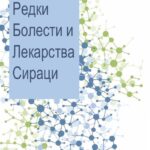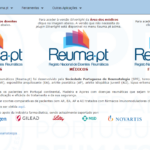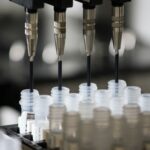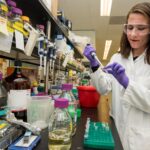 On December 31, 2019, the World Health Organization reported cases of pneumonia of unknown etiology. Аuthorities published later the main cause – coronavirus (SARS-CoV-2) which was the reason billions of people to be placed under social isolation. As any other communicable disease affecting public health, there is an increasing awareness among people who have co-morbidities or bleeding disorders, such as hemophilia and other rare diseases. For more information click here.
On December 31, 2019, the World Health Organization reported cases of pneumonia of unknown etiology. Аuthorities published later the main cause – coronavirus (SARS-CoV-2) which was the reason billions of people to be placed under social isolation. As any other communicable disease affecting public health, there is an increasing awareness among people who have co-morbidities or bleeding disorders, such as hemophilia and other rare diseases. For more information click here.
informer
Clinical case of a patient with plexus brachialis neurofibroma – the role of physiotherapy in a multidisciplinary team
 We present a clinical case of a patient diagnosed at age 9 with plexus brachialis neurofibroma. The purpose is to monitor the diagnostic and therapeutic procedures of the multidisciplinary team with an emphasis on the effectiveness of physiotherapy for full recovery. The complexity of the pathology requires collaboration in a multidisciplinary team, with the emphasis being on the role of physiotherapy and its rehabilitation in the recovery of the patient. Magnetic resonance imaging shows the tumor formation in the cervical region, surgically removed, after the completion of four courses of physiotherapy the full volume of active movements in the respective joints is restored. As a result of early initiated, comprehensive and individually targeted physiotherapy and rehabilitation after surgery, complete recovery of the patient is achieved. For more information click here.
We present a clinical case of a patient diagnosed at age 9 with plexus brachialis neurofibroma. The purpose is to monitor the diagnostic and therapeutic procedures of the multidisciplinary team with an emphasis on the effectiveness of physiotherapy for full recovery. The complexity of the pathology requires collaboration in a multidisciplinary team, with the emphasis being on the role of physiotherapy and its rehabilitation in the recovery of the patient. Magnetic resonance imaging shows the tumor formation in the cervical region, surgically removed, after the completion of four courses of physiotherapy the full volume of active movements in the respective joints is restored. As a result of early initiated, comprehensive and individually targeted physiotherapy and rehabilitation after surgery, complete recovery of the patient is achieved. For more information click here.
 Retinitis pigmentosa and Leber’s congenital amaurosis are rare inherited retinal distrophies that lead to irreversible blindness. The remarkable genetic heterogeneity of these diseases is due not only to the large number of genes involved, but also to the fact that mutations in a particular gene can cause different phenotypic variants, varying in severity, disease progression and inheritance. Logically, there is no unified classification that combines all clinical and genetic forms of the retinal pigment dystrophies. In this context, epidemiological research in clinical practice encompasses the studied contingents by different clinical-genetic and age criteria. This makes it extremely difficult to study and evaluate the epidemiology of the various forms of inherited retinal dystrophy. Despite the existence of clinical experience and a thorough knowledge of these diseases in Bulgaria, there is no published epidemiological data for the local population. This publication aims to analyze epidemiological data on retinitis pigmentosa and Leber congenital amaurosis and to provide an epidemiological assessment of the prevalence of these diseases in Bulgaria. For more information click here.
Retinitis pigmentosa and Leber’s congenital amaurosis are rare inherited retinal distrophies that lead to irreversible blindness. The remarkable genetic heterogeneity of these diseases is due not only to the large number of genes involved, but also to the fact that mutations in a particular gene can cause different phenotypic variants, varying in severity, disease progression and inheritance. Logically, there is no unified classification that combines all clinical and genetic forms of the retinal pigment dystrophies. In this context, epidemiological research in clinical practice encompasses the studied contingents by different clinical-genetic and age criteria. This makes it extremely difficult to study and evaluate the epidemiology of the various forms of inherited retinal dystrophy. Despite the existence of clinical experience and a thorough knowledge of these diseases in Bulgaria, there is no published epidemiological data for the local population. This publication aims to analyze epidemiological data on retinitis pigmentosa and Leber congenital amaurosis and to provide an epidemiological assessment of the prevalence of these diseases in Bulgaria. For more information click here.
 The assessment of innovation and the value of new medicinal therapies, has been repeatedly commented in “Rare Diseases and Orphan Drugs” journal. This is a key point in health technology assessment, which is often used by industry to justify the high cost of a particular drug. Innovation itself is a broad concept. However, when it comes to the value and assessment of health technologies, an important dimension of the innovation of a therapy is its added benefits. Not benefits, but added benefits. This is the link between pricing and cost of treatment with the health technology in question. For more information click here.
The assessment of innovation and the value of new medicinal therapies, has been repeatedly commented in “Rare Diseases and Orphan Drugs” journal. This is a key point in health technology assessment, which is often used by industry to justify the high cost of a particular drug. Innovation itself is a broad concept. However, when it comes to the value and assessment of health technologies, an important dimension of the innovation of a therapy is its added benefits. Not benefits, but added benefits. This is the link between pricing and cost of treatment with the health technology in question. For more information click here.
 The new issue of our scientific journal Rare Diseases and Orphan Drugs is now online. The issue contains 4 publications on various topics. The editorial is “Innovation, added benefits and pricing in health technology assessment”. If you would like to receive the latest information on rare diseases and orphan drugs, how the diagnostics and treatment is performed Bulgaria, please follow the link.
The new issue of our scientific journal Rare Diseases and Orphan Drugs is now online. The issue contains 4 publications on various topics. The editorial is “Innovation, added benefits and pricing in health technology assessment”. If you would like to receive the latest information on rare diseases and orphan drugs, how the diagnostics and treatment is performed Bulgaria, please follow the link.
 The vasculitides are a group of rare diseases with different manifestations and outcomes. New therapeutic options have led to the need for long-term registries. The Rheumatic Diseases Portuguese Register, Reuma.pt, is a web-based electronic clinical record, created in 2008, which currently includes specific modules for 12 diseases and > 20,000 patients registered from 79 rheumatology centres. On October 2014, a dedicated module for vasculitis was created as part of the European Vasculitis Society collaborative network, enabling prospective collection and central storage of encrypted data from patients with this condition. All Portuguese rheumatology centres were invited to participate. Data regarding demographics, diagnosis, classification criteria, assessment tools, and treatment were collected. We aim to describe the structure of Reuma.pt/vasculitis and characterize the patients registered since its development. For more information click here.
The vasculitides are a group of rare diseases with different manifestations and outcomes. New therapeutic options have led to the need for long-term registries. The Rheumatic Diseases Portuguese Register, Reuma.pt, is a web-based electronic clinical record, created in 2008, which currently includes specific modules for 12 diseases and > 20,000 patients registered from 79 rheumatology centres. On October 2014, a dedicated module for vasculitis was created as part of the European Vasculitis Society collaborative network, enabling prospective collection and central storage of encrypted data from patients with this condition. All Portuguese rheumatology centres were invited to participate. Data regarding demographics, diagnosis, classification criteria, assessment tools, and treatment were collected. We aim to describe the structure of Reuma.pt/vasculitis and characterize the patients registered since its development. For more information click here.
 Type 1 Usher syndrome (USH1) is a rare disease and major cause of genetic deaf-blindness. Deafness is present from birth while retinitis pigmentosa (RP) which typically presents during childhood is progressive leading to blindness. The aim of this research was to develop a disease model describing USH1 symptoms and their impact on patients’ lives. Qualitative interviews were conducted with patients (pediatric and adult) and parents of children and adolescents with USH1. Interviewed subjects were enrolled through ophthalmologists from specialized eye centers in the USA and in France. Trained interviewers used semi-structured techniques to elicit concepts relevant to patients and their parents. Thematic analysis of interview transcripts led to the identification of concepts which were organized to generate a disease model. For more information click here.
Type 1 Usher syndrome (USH1) is a rare disease and major cause of genetic deaf-blindness. Deafness is present from birth while retinitis pigmentosa (RP) which typically presents during childhood is progressive leading to blindness. The aim of this research was to develop a disease model describing USH1 symptoms and their impact on patients’ lives. Qualitative interviews were conducted with patients (pediatric and adult) and parents of children and adolescents with USH1. Interviewed subjects were enrolled through ophthalmologists from specialized eye centers in the USA and in France. Trained interviewers used semi-structured techniques to elicit concepts relevant to patients and their parents. Thematic analysis of interview transcripts led to the identification of concepts which were organized to generate a disease model. For more information click here.
 Celocentesis, is an invasive technique that can provide prenatal diagnosis of single gene disorders, from as early as seven weeks’ gestation. The objective of this study is to examine the safety of celocentesis. Celocentesis was performed for prenatal diagnosis of hemoglobinopathies in 402 singleton pregnancies, in which both parents were carriers of thalassaemia or sickle cell disease trait. We assessed procedure-related maternal discomfort or pain, success of sampling and obtaining of results, pregnancy outcome and postnatal follow up. For more information click here.
Celocentesis, is an invasive technique that can provide prenatal diagnosis of single gene disorders, from as early as seven weeks’ gestation. The objective of this study is to examine the safety of celocentesis. Celocentesis was performed for prenatal diagnosis of hemoglobinopathies in 402 singleton pregnancies, in which both parents were carriers of thalassaemia or sickle cell disease trait. We assessed procedure-related maternal discomfort or pain, success of sampling and obtaining of results, pregnancy outcome and postnatal follow up. For more information click here.
 Most patients with alpha-1 antitrypsin deficiency remain undiagnosed and therefore do not benefit from current therapies or become eligible for research studies of new treatments under development. Improving the detection rate for AATD is therefore a high priority for the Alpha-1 Foundation. A workshop was held on June 23, 2019 in Orlando, Florida during which stakeholders from the research, pharmaceutical, and patient communities focused on the topic of alpha-1 antitrypsin deficiency detection. A variety of detection strategies have been explored in the past and new approaches are emerging as technology advances. Targeted detection includes patients with chronic obstructive pulmonary disease, unexplained chronic liver disease, and family members of affected individuals. Newborn screening, electronic medical record data mining, and direct-to-consumer testing remain options for future detection strategies. For more information click here.
Most patients with alpha-1 antitrypsin deficiency remain undiagnosed and therefore do not benefit from current therapies or become eligible for research studies of new treatments under development. Improving the detection rate for AATD is therefore a high priority for the Alpha-1 Foundation. A workshop was held on June 23, 2019 in Orlando, Florida during which stakeholders from the research, pharmaceutical, and patient communities focused on the topic of alpha-1 antitrypsin deficiency detection. A variety of detection strategies have been explored in the past and new approaches are emerging as technology advances. Targeted detection includes patients with chronic obstructive pulmonary disease, unexplained chronic liver disease, and family members of affected individuals. Newborn screening, electronic medical record data mining, and direct-to-consumer testing remain options for future detection strategies. For more information click here.
 Mitochondrial disorders are a group of rare diseases, caused by nuclear or mitochondrial DNA mutations. Their marked clinical and genetic heterogeneity as well as referral and ascertainment biases render phenotype-based prevalence estimations difficult. Here we calculated the lifetime risk of all known autosomal recessive mitochondrial disorders on basis of genetic data. We queried the publicly available Genome Aggregation Database (gnomAD) and our in-house exome database to assess the allele frequency of disease-causing variants in genes associated with autosomal recessive mitochondrial disorders. Based on this, we estimated the lifetime risk of 249 autosomal recessive mitochondrial disorders. Three of these disorders and phenylketonuria (PKU) served as a proof of concept since calculations could be aligned with known birth prevalence data from newborn screening reports. For more information click here.
Mitochondrial disorders are a group of rare diseases, caused by nuclear or mitochondrial DNA mutations. Their marked clinical and genetic heterogeneity as well as referral and ascertainment biases render phenotype-based prevalence estimations difficult. Here we calculated the lifetime risk of all known autosomal recessive mitochondrial disorders on basis of genetic data. We queried the publicly available Genome Aggregation Database (gnomAD) and our in-house exome database to assess the allele frequency of disease-causing variants in genes associated with autosomal recessive mitochondrial disorders. Based on this, we estimated the lifetime risk of 249 autosomal recessive mitochondrial disorders. Three of these disorders and phenylketonuria (PKU) served as a proof of concept since calculations could be aligned with known birth prevalence data from newborn screening reports. For more information click here.
